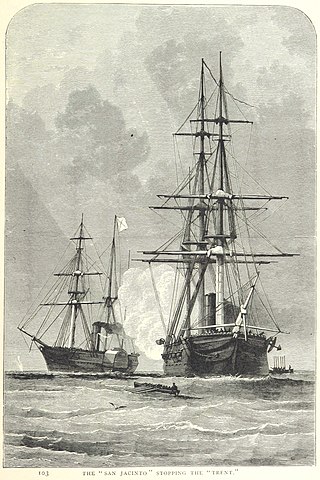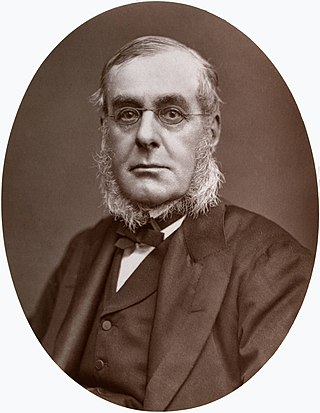
The Challenger expedition of 1872–1876 was a scientific programme that made many discoveries to lay the foundation of oceanography. The expedition was named after the naval vessel that undertook the trip, HMS Challenger.

USS Vincennes was a 703-ton Boston-class sloop of war in the United States Navy from 1826 to 1865. During her service, Vincennes patrolled the Pacific, explored the Antarctic, and blockaded the Confederate Gulf coast in the Civil War. Named for the Revolutionary War Battle of Vincennes, she was the first U.S. warship to circumnavigate the globe.

The first USS Powhatan was a sidewheel steam frigate in the United States Navy during the American Civil War. She was named for Powhatan, a Native American chief of eastern Virginia. She was one of the last, and largest, of the United States Navy's paddle frigates.
The first USS Levant was a second-class sloop-of-war in the United States Navy.

The second USS Porpoise was a 224-ton Dolphin-class brigantine. Porpoise was later re-rigged as a brig. She was based on the same plans as Dolphin.
USS Germantown was a United States Navy sloop-of-war in commission for various periods between 1847 and 1860. She saw service in the Mexican–American War in 1847–1848 and during peacetime operated in the Caribbean, in the Atlantic Ocean off Africa and South America, and in East Asia. Scuttled at the outbreak of the American Civil War in 1861, she was captured and refloated by the Confederate States of America and placed in service with the Confederate States Navy as the floating battery CSS Germantown before again being scuttled in 1862.

USS Ashuelot was an iron-hulled, double-ended, side-wheel Mohongo-class gunboat in the United States Navy. She was named for a river in New Hampshire.
USS John Hancock was an armed steam tug in the United States Navy during the 1850s. She was named for Founding Father John Hancock and saw action against rioters in Massachusetts, filbusters in Cuba, rebels in China, and Native Americans in the Washington Territory. She took part in a hydrographic surveying expedition to East Asia and the Pacific Ocean.

The first USS San Jacinto was an early screw frigate in the United States Navy during the mid-19th century. She was named for the San Jacinto River, site of the Battle of San Jacinto during the Texas Revolution. She is perhaps best known for her role in the Trent Affair of 1861.

Keying was a three-masted, 800-ton Fuzhou Chinese trading junk which sailed from China around the Cape of Good Hope to the United States and Britain between 1846 and 1848. Her voyage was significant as it was one of the earliest instances of a Chinese sailing vessel making a transoceanic journey to the Western world. It served as a cultural exchange and offered Western audiences a glimpse into Chinese maritime traditions and craftsmanship.

USS John A. Bole (DD-755), was an Allen M. Sumner-class destroyer of the United States Navy.

Admiral of the Fleet The Honourable Sir Henry Keppel was a Royal Navy officer. His first command was largely spent off the coast of Spain, which was then in the midst of the First Carlist War. As commanding officer of the corvette HMS Dido on the East Indies and China Station he was deployed in operations during the First Opium War and in operations against Borneo pirates. He later served as commander of the naval brigade besieging Sebastopol during the Crimean War. After becoming second-in-command of the East Indies and China Station, he commanded the British squadron in the action with Chinese pirates at the Battle of Fatshan Creek when he sank around 100 enemy war-junks. He subsequently took part in the capture of Canton during the Second Opium War.

The East India Squadron, or East Indies Squadron, was a squadron of American ships that existed in the nineteenth century. It focused on protecting American interests in the Far East, while the Pacific Squadron concentrated on the western coasts of the Americas and the South Pacific Ocean. Its duties included the Yangtze River Patrol in China. The East India Squadron was established in 1835 and existed until it became part of the Asiatic Squadron in 1868.

USS Asheville, the lead ship in her class of two United States Navy gunboats, was the first ship of the United States Navy named for the city of Asheville, North Carolina. The ship was built at the Charleston Naval Shipyard of North Charleston, South Carolina, from her keel laying in June 1918, her launching in July 1918, and her commissioning in July 1920.

Admiral Sir Richard Collinson was an English naval officer and explorer of the Northwest Passage.

HMS Hornet was a 17-gun wooden screw sloop of the Cruizer class of the Royal Navy, launched in 1854 and broken up in 1868.

The North Pacific Exploring and Surveying Expedition, also known as the Rodgers-Ringgold Expedition was a United States scientific and exploring project from 1853 to 1856.
USS Fenimore Cooper was a United States Navy schooner assigned as a ship’s tender to accompany a surveying expedition. After departing from Hampton Roads, Virginia, and navigating the Cape of Good Hope, the expedition traveled throughout the Pacific Ocean accumulating hydrographic information from the South China Sea to the Bering Strait in the Arctic and Alaska.

The Memnon was the first clipper ship to arrive in San Francisco after the Gold Rush, and the only clipper to arrive in San Francisco before 1850. Built in 1848, she made record passages to San Francisco and to China, and sailed in the first clipper race around Cape Horn.

The Commander-in-Chief, East Indies and China was a formation of the Royal Navy from 1831 to 1865. Its naval area of responsibility was the Indian Ocean and the coasts of China and its navigable rivers.















